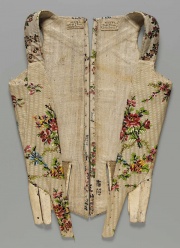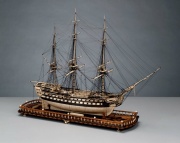Difference between revisions of "Baleen"
(username removed) |
|||
| (5 intermediate revisions by 2 users not shown) | |||
| Line 1: | Line 1: | ||
| − | [[File:43.656a-SC119860.jpg|thumb| | + | [[File:43.656a-SC119860.jpg|thumb|Corsette with whalebone<br>MFA# 43.656a]] |
== Description == | == Description == | ||
| − | + | [[File:32.146-E5256CR-d1.jpg|thumb|Ship model<br>MFA# 32.146]] | |
Baleen is a proteinaceous, horn-like material obtained from non-toothed whales of the suborder Mysticeti. Examples are the humpback, finback, minke, sei, blue ,and right whales. These whale have up to 700 parallel sheets of baleen that hang from the upper jaw and filter plankton or krill. The plates are about 0.5 centimeter apart, 1 centimeter thick and can reach lengths of 3-5 meters. They have a triangular shape with a finner, or fringe, on the inner angled side. Baleen is an elastic sheet that grows in a three-part structure consisting of a central section of hollow tubes sandwiched between two thin, shiny surfaces. The bone-like tubes are composed of hydroxyapatite. The semitransparent covering sheets are composed of keratin. Microscopically baleen is similar to horn; it is anisotropic and exhibits a full range of polarization colors. Baleen sheets have been used for a wide variety of applications ranging from baskets, fans, and small decorative articles to petticoat hoops, sled runners, and roof covers. The fibers from the finner have been used for brushes. Some species and colors are listed below: | Baleen is a proteinaceous, horn-like material obtained from non-toothed whales of the suborder Mysticeti. Examples are the humpback, finback, minke, sei, blue ,and right whales. These whale have up to 700 parallel sheets of baleen that hang from the upper jaw and filter plankton or krill. The plates are about 0.5 centimeter apart, 1 centimeter thick and can reach lengths of 3-5 meters. They have a triangular shape with a finner, or fringe, on the inner angled side. Baleen is an elastic sheet that grows in a three-part structure consisting of a central section of hollow tubes sandwiched between two thin, shiny surfaces. The bone-like tubes are composed of hydroxyapatite. The semitransparent covering sheets are composed of keratin. Microscopically baleen is similar to horn; it is anisotropic and exhibits a full range of polarization colors. Baleen sheets have been used for a wide variety of applications ranging from baskets, fans, and small decorative articles to petticoat hoops, sled runners, and roof covers. The fibers from the finner have been used for brushes. Some species and colors are listed below: | ||
| − | + | * Blue whale (''Balaenoptera musculus''): black plate with coarse black fringe | |
| − | + | * Fin whale (''Balaenoptera physalus''): gray and yellow (or white) striped plates with corresponding fringe colors | |
| − | + | * Sei whale (''Balaenoptera borealis''): blue-black plate with white, curly fringe | |
| − | + | * Humpback whale (Megaptera nodosa): gray to black plate and fringe | |
| − | |||
| − | + | For detailed information on baleen usage history, identification and care, please see the AIC Wiki for: | |
| + | * Baleen (Wooden Artifacts Group): [https://www.conservation-wiki.com/wiki/Baleen Baleen] | ||
| − | |||
== Synonyms and Related Terms == | == Synonyms and Related Terms == | ||
whalebone; finner fibers | whalebone; finner fibers | ||
| − | == | + | ==Physical and Chemical Properties== |
Finner fibers have an oval cross section and usually have a hollow medulla | Finner fibers have an oval cross section and usually have a hollow medulla | ||
| − | == | + | ==Resources and Citations== |
| − | |||
| − | |||
| − | |||
| − | |||
| − | |||
| − | |||
| − | |||
| − | |||
| − | |||
| − | + | * J.Lauffenburger "Baleen in Museum Collections: Its Sources, Uses and Identification" JAIC, 32:213-310, 1993. | |
* G.S.Brady, ''Materials Handbook'', McGraw-Hill Book Co., New York, 1971 Comment: p. 868 | * G.S.Brady, ''Materials Handbook'', McGraw-Hill Book Co., New York, 1971 Comment: p. 868 | ||
Latest revision as of 13:32, 5 October 2024
Description
Baleen is a proteinaceous, horn-like material obtained from non-toothed whales of the suborder Mysticeti. Examples are the humpback, finback, minke, sei, blue ,and right whales. These whale have up to 700 parallel sheets of baleen that hang from the upper jaw and filter plankton or krill. The plates are about 0.5 centimeter apart, 1 centimeter thick and can reach lengths of 3-5 meters. They have a triangular shape with a finner, or fringe, on the inner angled side. Baleen is an elastic sheet that grows in a three-part structure consisting of a central section of hollow tubes sandwiched between two thin, shiny surfaces. The bone-like tubes are composed of hydroxyapatite. The semitransparent covering sheets are composed of keratin. Microscopically baleen is similar to horn; it is anisotropic and exhibits a full range of polarization colors. Baleen sheets have been used for a wide variety of applications ranging from baskets, fans, and small decorative articles to petticoat hoops, sled runners, and roof covers. The fibers from the finner have been used for brushes. Some species and colors are listed below:
- Blue whale (Balaenoptera musculus): black plate with coarse black fringe
- Fin whale (Balaenoptera physalus): gray and yellow (or white) striped plates with corresponding fringe colors
- Sei whale (Balaenoptera borealis): blue-black plate with white, curly fringe
- Humpback whale (Megaptera nodosa): gray to black plate and fringe
For detailed information on baleen usage history, identification and care, please see the AIC Wiki for:
- Baleen (Wooden Artifacts Group): Baleen
Synonyms and Related Terms
whalebone; finner fibers
Physical and Chemical Properties
Finner fibers have an oval cross section and usually have a hollow medulla
Resources and Citations
- J.Lauffenburger "Baleen in Museum Collections: Its Sources, Uses and Identification" JAIC, 32:213-310, 1993.
- G.S.Brady, Materials Handbook, McGraw-Hill Book Co., New York, 1971 Comment: p. 868
- Van Nostrand's Scientific Encyclopedia, Douglas M. Considine (ed.), Van Nostrand Reinhold, New York, 1976
- The American Heritage Dictionary or Encarta, via Microsoft Bookshelf 98, Microsoft Corp., 1998
- Caring for your Collections, Arthur W Schulz (ed.), Harry N. Abrams, Inc. , New York, 1992
- F. Kidd, Brushmaking Materials, Bristish Brush Manufacturers, London, 1957

